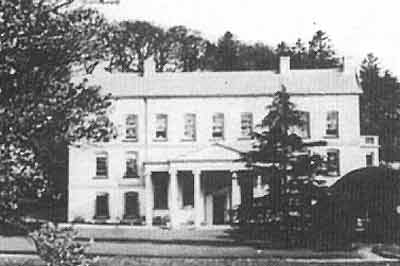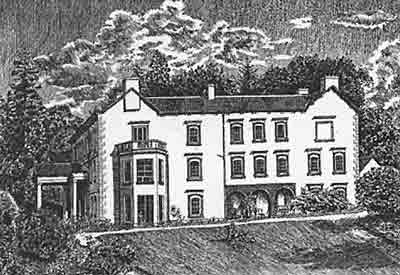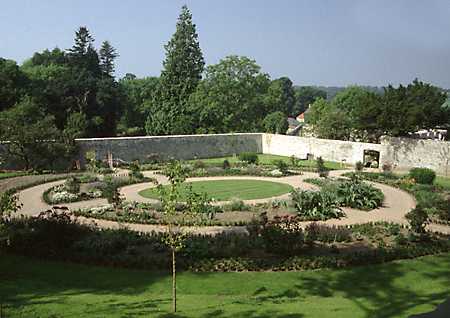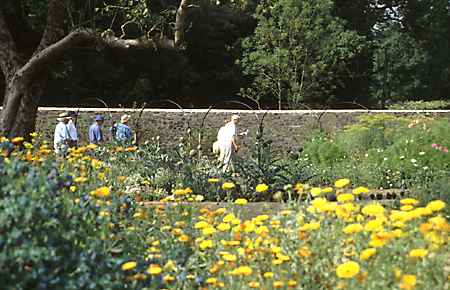Aberglasney is a remarkable garden restoration. The Aberglasney Restoration Trust have transformed a totally overgrown site with derelict buildings into an attractive, compartmentalised series of gardens.
The structural repairs to walls and cloisters are complete, and several areas are planted and provide Aberglasney with some useful colour.
Bishop Anthony Rudd, who bought Aberglasney around 1600, is probably responsible for much of the garden as we see it now. Robert Dyer gave the house a Queen Anne makeover from 1710 and the Ionic portico was added in the early 1800's by Thomas Philipps.
Photo of the front of Aberglasney House in 1870 with its portico (columned porch) Sketch of the back of Aberglasney House in 1947 The facade of the house has been restored and the portico has been returned to its rightful place, after being stolen and then fortunately spotted by someone in a Christie's auction! The splendid Ionic portico was added to the north façade around the time Victoria came to the throne (1837). By the time the Aberglasney Restoration Trust was germinating, 150 years later, it had vanished. Someone spotted the columns advertised in a Christie's catalogue, and since Aberglasney was a listed building their removal and sale was illegal. After a court case (which drew public attention to the critical state of Aberglasney, and advanced the cause of rescue and restoration), the columns were retrieved and put into storage pending the full restoration of the portico. A side-benefit of the unlawful dismantling of the structure was to reveal a handsome roundel hidden behind the pediment. Only then were buildings historians able to appreciate the high quality of the Queen Anne architecture commissioned by Robert Dyer, the new owner between 1710 and 1720. The sight gave some pause to regret the fact that by law this must disappear once again behind an ostentatious Victorian addition. At this stage the house is still just a shell, but looking nonetheless impressive.At the edge of the north lawn is a yew tunnel, thought to be around 275 years old. Alongside the tunnel is Aberglasney's original gatehouse, thought by some to have been a folly. Excavation revealed an attractive cobbled drive, worn over many years by horse drawn carriages, confirming its function as a gatehouse.
The cloister garden will probably become the centrepiece of Aberglasney, enclosed on two sides by walls, one side by the cloisters, the house on the fourth side, with a Victorian fountain at its centre. When the Trust began work at Aberglasney, this area was filled with soil to the top of the arches on the cloisters.
A parapet walk around the cloisters offers wonderful views over the gardens, enabling you to appreciate it from an entirely different perspective.
A terrace across the back of the tea room enjoys views over the Pool Garden towards the Kitchen Garden and Stream Garden. There are a couple of short woodland walks leading from the garden.
Aberglasney Garden offers access for wheelchair users, but watch out for the building work.
Facilities: Café, Disabled Facilities, Gardens, Toilets, Walks
Aberglasney Gardens cover approximately 9 acres, including two woodlands. Firm gravel pathways connect all elements of the garden and wheelchair users are able to visit most of the areas within the garden. Two wheelchairs are available for use by visitors at no extra charge (please, if possible, book in advance to ensure availability).
Within the garden is a tea room which is open from 10.00am to 5.30pm, providing tea, coffee, cakes etc. throughout the day.
Light lunches are served from 12.00am to 2.00pm.
For further information on other local attractions, accommodation and places to eat, please follow this link to the Carmarthenshire Tourist Association site at:
http://www.visit-carmarthenshire.co.uk
Aberglasney is situated at the small village of Llangathen, 400 yards from the A40 at Broad Oak (4 miles west of Llandeilo and 12 miles east of Carmarthen). Details can be found on the internet at:
http://www.aberglasney.org/visitorscentre.html
http://www.leisurebritain.co.uk : (In the Enter County box, scroll down to Carmarthenshire where Middelton Hall will be found).
Date this page last updated: April 11, 2011




